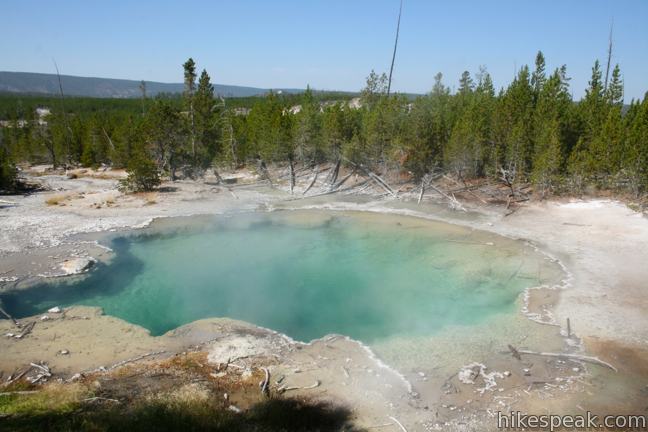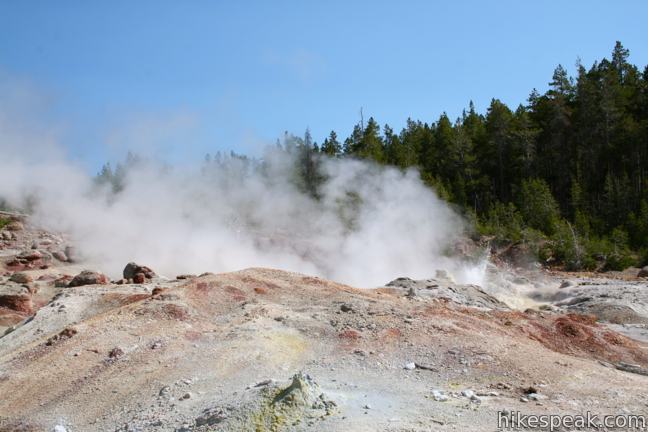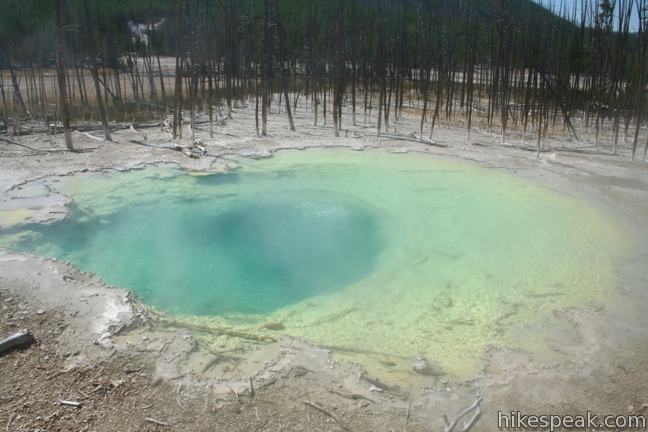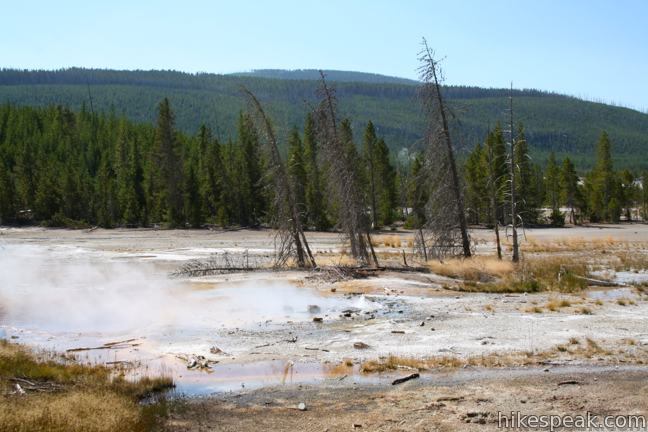Back Basin Trail in Norris Geyser Basin
in Yellowstone National Park

Norris Geyser Basin is home to Steamboat Geyser, the tallest geyser in the world, found on Back Basin Trail. You’ll have to get quite lucky to see Steamboat at full strength, as the geyser can go 50 years between major eruptions. Back Basin Trail is a 1.75-mile loop passing numerous hot springs and geysers. You can cut that distance in half by exploiting a shortcut just past Steamboat Geyser. There is minimal elevation change along both routes, and plenty to see.
Unlike the sun-exposed boardwalk through Porcelain Basin or the north side of Norris Geyser Basin, Back Basin passes through a pine forest that can offer refreshing summer shade, while still exploring some amazing hydrothermal features.

Leaving from the Norris Geyser Basin Museum and Bookstore, the first attraction reached heading down the northeast side of the loop is Emerald Spring. Minerals in the water of most hot springs a blue color, so how did this alluring vibrant green pool get its color? A sign along the trail explains that the secret ingredient is sulfur:
A hot spring’s color often indicates the presence of minerals. In a clear blue pool, the water is absorbing all the colors of sunlight except one—blue, which is reflected back to our eyes. Here in Emerald Spring’s pool, another factor joins with light refraction to give this spring its color. The 27-foot-deep pool (8 meters) is lined with yellow sulfur deposits. The yellow color from the sulfur combines with the reflected blue light, making the hot spring appear a magnificent emerald green.
After a lesson in color combinations, the boardwalk slips through more pines and arrives at Steamboat Geyser. As you stand below the world’s tallest geyser, visualize the record-setting 300 to 400-foot shafts of water that have been recorded at Steamboat Geyser. These massive eruptions are quite rare, so you are more likely to see plumes of steam and small eruptions about ten feet tall.
A sign alongside Steamboat Geyser compels you to learn to love the unpredictable:
When Steamboat Geyser erupts, it can rocket a column of scalding water 90-120 meters into the air—two to three times the average height of Old Faithful. Steam roars for twenty-four hours after. Odds are against you witnessing this drama, however, since Steamboat’s major eruptions occur 4 days to 50 years apart. In Yellowstone’s geyser basins, unpredictability is the pattern. Old Faithful’s relatively predictable intervals are the exception. An earthquake could disrupt Old Faithful’s timetable, or a shift in subterranean plumbing could allow Steamboat more frequent eruptions.
Even through you aren’t likely to see one of Steamboat Geyser’s rare and unpredictable eruptions, the regular bursts of steam and water are still entertaining to watch.

When you tire of waiting for a major eruption from Steamboat Geyser, continue along Back Basin Trail to a T-junction. To the left you can continue toward the back of back basin and hydrothermal features like Black Pit Spring, Echinus Geyser, Arch Steam Vent, Mystic Spring, Puff ‘n Stuff Geyser, Black Hermit Caldron, Green Dragon Spring, Blue Mud Steam Vent, Yellow Funnel Spring, Porkchop Geyser, Pearl Geyser, and Vixen Geyser. For those with less time, the alternative is to turn right and head down the steps toward Cistern Spring on a roughly 1-mile long loop that is 0.75 miles shorter than the full loop through the Back Basin of Norris Geyser Basin.
The next stop on the shorter loop is Cistern Spring, a blue-green pool wrapped by pines. Geyser basin plumbers have determined that Cistern Spring and Steamboat Spring are connected underground. After Steamboat Geyser has a major eruption, Cistern Spring will empty and spend the next couple days refilling in order to return to its usual state as an overflowing blue pool.

If it appears that Cistern Spring is overtaking the surrounding lodgepole pines, that’s because this hot spring deposits about a hundred times more sinter each year (about half an inch) than other hydrothermal features like Old Faithful. The pines around the overflowing pool are indeed in jeopardy of being overtaken.
After passing Veteran Geyser, the shortcut meets back up with the longer Back Basin Trail. Turn right and you will quickly pass Palpitator Spring, Fearless Geyser, and Monarch Geyser. The last labeled geyser on the loop is Minute Geyser. For the first half of the 20th century, Minute Geyser was a popular geyser to visit because, as its name implies, it erupted every minute. This all changed when tourists threw rocks into the geyser’s main hole, clogging the artery and forever changing the geyser’s eruptions. The once-a-minute eruptions, sometimes as high as 50 feet, have been replaced with unpredictable and less dramatic eruptions from a smaller vent that was not clogged by the rocks. Geysers are among the most rare features on earth, so please avoid creating another Minute Geyser and do not use any of Yellowstone’s geysers like wishing wells.

Leave Minute Geyser and pass through more lodgepole pines to complete the loop and return to the Norris Geyser Basin Museum near the start of Porcelain Basin Trail. There is an entrance fee for Yellowstone National Park, but no permit is required to hike Back Basin Trail in Norris Geyser Basin. Stay on the boardwalk and trail, and do not touch any hydrothermal features.
To get to the trailhead: Drive to the intersection of Grand Loop Road and Norris Canyon Road and go west into the parking area for Norris Geyser Basin. From Madison Junction drive 13 miles northeast on Grand Loop Road (Route 89) to reach Norris Canyon Road, or drive 21 miles south on Route 89 from Mammoth Hot Springs. From the Canyon Area, drive 11.5 miles west on Norris Canyon Road to reach the trailhead.
Trailhead address: Grand Loop Road & Norris Canyon Road, Yellowstone National Park, WY 82190
Trailhead coordinates: 44.726133, -110.701998 (44° 43′ 34.07″N 110° 42′ 07.19″W)
You may also view a regional map of surrounding Wyoming trails and campgrounds.
 | Porcelain Basin of Norris Geyser Basin This pair of loops explores a stark basin with an impressive collection of geysers and hot springs. |
 | Monument Geyser Basin This 2.8-mile hike reaches a rarely visited hydrothermal area that is boardwalk-free and fun to explore. |
 | Artists' Paintpots This 1.1-mile hike circles a hillside hydrothermal area, passing bursting mudpots, bubbling hot springs, and mesmerizing milky blue pools. |
 | Mammoth Hot Springs This series of boardwalks explores a park highlight, a collection of colorful hot springs terraces. |
 | Boiling River This 1.25-mile round trip hike follows a riverbank to a natural hot tub where a stream of water cooked by nearby hydrothermal features mixes with the river. |
 | Fountain Paint Pot This half-mile loop in Lower Geyser Basin passes geysers, hot springs, mudpots, and fumaroles - all of the hydrothermal features found in Yellowstone. |
 | Midway Geyser Basin This 0.8 mile walkway passes Excelsior Geyser and Grand Prismatic Spring, the largest hot springs in Yellowstone. |
 | Biscuit Basin This 2/3 of a mile loop explores hydrothermal features in Upper Geyser Basin like Black Opal Pool, Sapphire Pool, and Black Pearl Geyser. |
 | Old Faithful Geyser The tall, frequent eruptions of Yellowstone's most famous geyser have been dazzling visitors for over a century and are easy to witness today. |
 | More trails in Yellowstone Explore other hikes to waterfalls and hydrothermal hot spots in Yellowstone National Park. |
 | Yellowstone National Park Campgrounds There are 12 developed campgrounds with over 2,000 total sites spread throughout Yellowstone. |










This is a totally rewarding experience and worth the walk around the Back Basin. The boardwalks and paths are not a challenge at the elevation. You can count on lots of variety here too. The geothermal attractions, especially Steamboat Geyser, are a real wonder.
[…] Norris Geyser Basin (Porcelain Basin and Black Basin). The drive between Grand Canyon of the Yellowstone and the Norris Geyser Basin is approximately […]